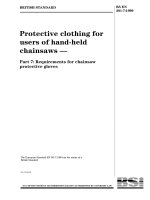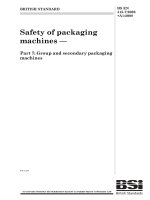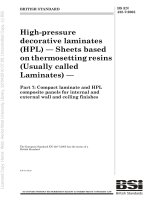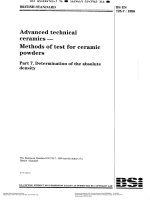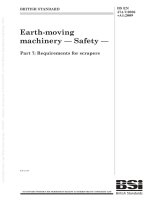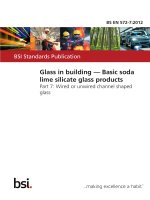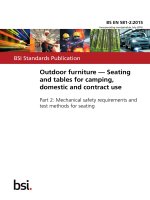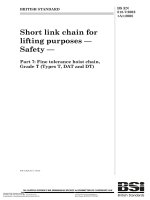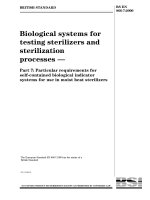Bsi bs en 61800 7 202 2016
Bạn đang xem bản rút gọn của tài liệu. Xem và tải ngay bản đầy đủ của tài liệu tại đây (9 MB, 296 trang )
BS EN 61800-7-202:2016
BSI Standards Publication
Adjustable speed electrical
power drive systems
Part 7-202: Generic interface and use of
profiles for power drive systems — Profile
type 2 specification
BS EN 61800-7-202:2016 BRITISH STANDARD
National foreword
This British Standard is the UK implementation of EN 61800-7-202:2016. It
is identical to IEC 61800-7-202:2015. It supersedes BS EN 61800-7-202:2008,
which will be withdrawn on 12 October 2018.
The UK participation in its preparation was entrusted to Technical
Committee PEL/22, Power electronics.
A list of organizations represented on this committee can be obtained on
request to its secretary.
This publication does not purport to include all the necessary provisions of
a contract. Users are responsible for its correct application.
© The British Standards Institution 2016.
Published by BSI Standards Limited 2016
ISBN 978 0 580 82129 5
ICS 29.200; 35.100.05
Compliance with a British Standard cannot confer immunity from
legal obligations.
This British Standard was published under the authority of the
Standards Policy and Strategy Committee on 31 March 2016.
Amendments/corrigenda issued since publication
Date Text affected
EUROPEAN STANDARD BS EN 61800-7-202:2016
NORME EUROPÉENNE
EUROPÄISCHE NORM EN 61800-7-202
ICS 29.200; 35.100.05 February 2016
Supersedes EN 61800-7-202:2008
English Version
Adjustable speed electrical power drive systems -
Part 7-202: Generic interface and use of profiles for power drive
systems - Profile type 2 specification
(IEC 61800-7-202:2015)
Entrnements électriques de puissance à vitesse variable - Elektrische Leistungsantriebssysteme mit einstellbarer
Partie 7-202: Interface générique et utilisation de profils Drehzahl - Teil 7-202: Generisches Interface und Nutzung
pour les entrnements électriques de puissance -
Spécification de profil de type 2 von Profilen für Leistungsantriebssysteme (PDS) -
(IEC 61800-7-202:2015) Spezifikation von Profil-Typ 2
(IEC 61800-7-202:2015)
This European Standard was approved by CENELEC on 2015-12-25. CENELEC members are bound to comply with the CEN/CENELEC
Internal Regulations which stipulate the conditions for giving this European Standard the status of a national standard without any alteration.
Up-to-date lists and bibliographical references concerning such national standards may be obtained on application to the CEN-CENELEC
Management Centre or to any CENELEC member.
This European Standard exists in three official versions (English, French, German). A version in any other language made by translation
under the responsibility of a CENELEC member into its own language and notified to the CEN-CENELEC Management Centre has the
same status as the official versions.
CENELEC members are the national electrotechnical committees of Austria, Belgium, Bulgaria, Croatia, Cyprus, the Czech Republic,
Denmark, Estonia, Finland, Former Yugoslav Republic of Macedonia, France, Germany, Greece, Hungary, Iceland, Ireland, Italy, Latvia,
Lithuania, Luxembourg, Malta, the Netherlands, Norway, Poland, Portugal, Romania, Slovakia, Slovenia, Spain, Sweden, Switzerland,
Turkey and the United Kingdom.
European Committee for Electrotechnical Standardization
Comité Européen de Normalisation Electrotechnique
Europäisches Komitee für Elektrotechnische Normung
CEN-CENELEC Management Centre: Avenue Marnix 17, B-1000 Brussels
© 2016 CENELEC All rights of exploitation in any form and by any means reserved worldwide for CENELEC Members.
Ref. No. EN 61800-7-202:2016 E
BS EN 61800-7-202:2016
EN 61800-7-202:2016
European foreword
The text of document 22G/308/FDIS, future edition 2 of IEC 61800-7-202, prepared by
SC 22G “Adjustable speed electric drive systems incorporating semiconductor power converters” of
IEC/TC 22 “Power electronic systems and equipment" was submitted to the IEC-CENELEC parallel
vote and approved by CENELEC as EN 61800-7-202:2016.
The following dates are fixed:
• latest date by which the document has to be (dop) 2016-09-25
implemented at national level by (dow) 2018-12-25
publication of an identical national
standard or by endorsement
• latest date by which the national
standards conflicting with the
document have to be withdrawn
This document supersedes EN 61800-7-202:2008.
Attention is drawn to the possibility that some of the elements of this document may be the subject of
patent rights. CENELEC [and/or CEN] shall not be held responsible for identifying any or all such
patent rights.
Endorsement notice
The text of the International Standard IEC 61800-7-202:2015 was approved by CENELEC as a
European Standard without any modification.
In the official version, for Bibliography, the following notes have to be added for the standards indicated:
IEC 61131-3 NOTE Harmonized as EN 61131-3.
IEC 61158 Series NOTE Harmonized as EN 61158 Series.
IEC 61158-2:2014 NOTE Harmonized as EN 61158-2:2014 (not modified).
IEC 61158-3-2:2014 NOTE Harmonized as EN 61158-3-2:2014 (not modified).
IEC 61499-1:2005 NOTE Harmonized as EN 61499-1:2005 1) (not modified).
IEC 61784-1:2014 NOTE Harmonized as EN 61784-1:2014 (not modified).
IEC 61784-2:2014 NOTE Harmonized as EN 61784-2:2014 (not modified).
IEC 61800 Series NOTE Harmonized as EN 61800 Series.
IEC 61800-7 Series NOTE Harmonized as EN 61800-7 Series.
IEC 61800-7-201 NOTE Harmonized as EN 61800-7-201.
IEC 61800-7-203 NOTE Harmonized as EN 61800-7-203.
IEC 61800-7-204 NOTE Harmonized as EN 61800-7-204.
IEC 61800-7-301 NOTE Harmonized as EN 61800-7-301.
IEC 61800-7-302 NOTE Harmonized as EN 61800-7-302.
IEC 61800-7-303 NOTE Harmonized as EN 61800-7-303.
IEC 61800-7-304 NOTE Harmonized as EN 61800-7-304.
IEC 62026-3 NOTE Harmonized as EN 62026-3.
1) Superseded by EN 61499-1:2013 (IEC 61499-1:2012).
2
BS EN 61800-7-202:2016
EN 61800-7-202:2016
Annex ZA
(normative)
Normative references to international publications
with their corresponding European publications
The following documents, in whole or in part, are normatively referenced in this document and are
indispensable for its application. For dated references, only the edition cited applies. For undated
references, the latest edition of the referenced document (including any amendments) applies.
NOTE 1 When an International Publication has been modified by common modifications, indicated by (mod), the relevant
EN/HD applies.
NOTE 2 Up-to-date information on the latest versions of the European Standards listed in this annex is available here:
www.cenelec.eu
Publication Year Title EN/HD Year
IEC 60204-1 - -
IEC 61158-4-2 2014 Safety of machinery - Electrical equipment EN 60204-1 2014
IEC 61158-5-2 2014 of machines - 2014
IEC 61158-6-2 2014 Part 1: General requirements 2014
IEC 61588 2009 -
IEC 61800-7-1 2015 Industrial communication networks - EN 61158-4-2 2016
Fieldbus specifications -
IEEE Std 112 2004 Part 4-2: Data-link layer protocol -
specification - Type 2 elements
Industrial communication networks - EN 61158-5-2
Fieldbus specifications -
Part 5-2: Application layer service definition -
Type 2 elements
Industrial communication networks - EN 61158-6-2
Fieldbus specifications -
Part 6-2: Application layer protocol
specification - Type 2 elements
Precision clock synchronization protocol -
for networked measurement and control
systems
Adjustable speed electrical power drive EN 61800-7-1
systems -
Part 7-1: Generic interface and use of
profiles for power drive systems - Interface
definition
IEEE Standard Test Procedure for -
Polyphase Induction Motors and Generators
3
– 2 – BS EN 61800-7-202:2016
IEC 61800-7-202:2015 © IEC 2015
CONTENTS
FOREWORD......................................................................................................................... 10
INTRODUCTION................................................................................................................... 12
0.1 General ......................................................................................................................... 12
0.2 Patent declaration ......................................................................................................... 15
1 Scope ............................................................................................................................ 17
2 Normative references .................................................................................................... 17
3 Terms, definitions and abbreviated terms ......................................................................17
3.1 Terms and definitions............................................................................................17
3.2 Abbreviated terms.................................................................................................25
4 Overview ....................................................................................................................... 25
4.1 General................................................................................................................. 25
4.2 Control modes ...................................................................................................... 26
4.2.1 General ......................................................................................................... 26
4.2.2 Control methods ............................................................................................ 26
4.2.3 Control nomenclature ....................................................................................27
4.2.4 Position control..............................................................................................27
4.2.5 Velocity control .............................................................................................. 28
4.2.6 Acceleration control ....................................................................................... 30
4.2.7 Torque control ............................................................................................... 30
4.2.8 No Control ..................................................................................................... 31
5 Data types ..................................................................................................................... 32
5.1 Data type overview ............................................................................................... 32
5.2 Conventions.......................................................................................................... 32
6 CIP Motion drive profile ................................................................................................. 32
6.1 Object model ........................................................................................................ 32
6.1.1 Object overview ............................................................................................. 32
6.1.2 Object description..........................................................................................33
6.2 How objects affect behavior .................................................................................. 34
6.3 Defining object interfaces......................................................................................34
6.4 I/O connection messages ......................................................................................35
6.4.1 General ......................................................................................................... 35
6.4.2 CIP Motion I/O Connection ............................................................................ 35
6.4.3 Controller-to-Device Connection ....................................................................39
6.4.4 Device-to-Controller Connection ....................................................................59
6.4.5 Fixed Motion I/O connection format ...............................................................68
6.4.6 CIP Motion I/O Connection timing model........................................................69
6.5 Device startup procedure ...................................................................................... 85
6.5.1 General ......................................................................................................... 85
6.5.2 Motion I/O Connection creation......................................................................85
6.5.3 Motion Device Axis Object configuration ........................................................88
6.5.4 Time Synchronization .................................................................................... 90
6.6 Device visualisation .............................................................................................. 92
6.7 Ethernet/IP Quality of Service (QoS) .....................................................................93
7 Motion Device Axis Object ............................................................................................. 93
7.1 General considerations ......................................................................................... 93
BS EN 61800-7-202:2016 – 3 –
IEC 61800-7-202:2015 © IEC 2015
7.1.1 General ......................................................................................................... 93
7.1.2 Revision history .............................................................................................93
7.1.3 Object overview ............................................................................................. 93
7.1.4 Motion Device Axis Object abstraction ...........................................................94
7.1.5 Motion Control Axis Object ............................................................................ 95
7.1.6 Device control classification...........................................................................95
7.1.7 Required vs. Optional in implementation ........................................................96
7.2 Class attributes ................................................................................................... 107
7.2.1 General ....................................................................................................... 107
7.2.2 Semantics.................................................................................................... 111
7.3 Instance attributes .............................................................................................. 114
7.3.1 General ....................................................................................................... 114
7.3.2 Motion Control configuration attributes ........................................................ 116
7.3.3 Motion Scaling attributes ............................................................................. 117
7.3.4 Connection Data attributes .......................................................................... 123
7.3.5 Motor attributes ........................................................................................... 129
7.3.6 Feedback attributes ..................................................................................... 140
7.3.7 Event Capture attributes .............................................................................. 149
7.3.8 Command reference generation attributes ................................................... 155
7.3.9 Control mode attributes ............................................................................... 158
7.3.10 Stopping & Braking attributes ...................................................................... 176
7.3.11 DC Bus Control attributes ............................................................................ 186
7.3.12 Power and thermal management attributes .................................................. 190
7.3.13 Axis Status attributes................................................................................... 193
7.3.14 Exception, fault, and alarm attributes ........................................................... 199
7.3.15 Fault and alarm Log attributes ..................................................................... 205
7.3.16 Exception limit attributes.............................................................................. 210
7.3.17 Axis exception action configuration attribute ................................................ 213
7.3.18 Initialization fault attributes .......................................................................... 215
7.3.19 Start inhibit attributes .................................................................................. 216
7.3.20 APR fault attributes ..................................................................................... 217
7.3.21 Axis statistical attributes .............................................................................. 219
7.3.22 Axis info attributes ....................................................................................... 219
7.3.23 General purpose I/O attributes..................................................................... 220
7.3.24 Local Mode attributes .................................................................................. 222
7.3.25 Axis Safety attributes................................................................................... 222
7.4 Common services ............................................................................................... 223
7.4.1 Supported services ...................................................................................... 223
7.4.2 Service specific data.................................................................................... 224
7.5 Object specific services ...................................................................................... 226
7.5.1 Supported services ...................................................................................... 226
7.5.2 Service specific data.................................................................................... 226
7.6 Behavior ............................................................................................................. 241
7.6.1 State model ................................................................................................. 241
7.6.2 State behavior ............................................................................................. 252
7.6.3 Fault and alarm behavior ............................................................................. 259
7.6.4 Start Inhibit behavior ................................................................................... 261
7.6.5 Visualization behavior.................................................................................. 261
7.6.6 Command generation behavior .................................................................... 266
– 4 – BS EN 61800-7-202:2016
IEC 61800-7-202:2015 © IEC 2015
7.6.7 Feedback interface behavior........................................................................ 271
7.6.8 Event Capture Behavior ............................................................................... 273
7.6.9 Control Mode behavior................................................................................. 274
Bibliography........................................................................................................................ 288
Figure 1 – Structure of IEC 61800-7......................................................................................15
Figure 2 – Open loop position control.................................................................................... 27
Figure 3 – Closed loop position control ................................................................................. 28
Figure 4 – Open loop velocity control ....................................................................................29
Figure 5 – Closed loop velocity control .................................................................................29
Figure 6 – Acceleration control ............................................................................................. 30
Figure 7 – Torque control......................................................................................................31
Figure 8 – No Control (Feedback Only) ................................................................................. 31
Figure 9 – Object Model for a CIP Motion device ..................................................................33
Figure 10 – CIP Motion I/O Connection model ......................................................................35
Figure 11 – CIP Motion I/O Connection channels ..................................................................36
Figure 12 – Controller-to-Device Connection format (Connection Point 2) .............................37
Figure 13 – Device-to-Controller Connection format (Connection Point 2) .............................38
Figure 14 – CIP Motion Controller-to-Device Connection format............................................39
Figure 15 – Connection Header ............................................................................................ 39
Figure 16 – Connection Format.............................................................................................39
Figure 17 – Connection Header ............................................................................................ 40
Figure 18 – Instance Data Block ........................................................................................... 43
Figure 19 – Instance Data Header ........................................................................................ 43
Figure 20 – Cyclic Data Block ............................................................................................... 44
Figure 21 – Control Mode ..................................................................................................... 44
Figure 22 – Feedback Mode.................................................................................................. 44
Figure 23 – Cyclic Write Data Block ...................................................................................... 50
Figure 24 – Cyclic Write Data Block example ........................................................................ 50
Figure 25 – Event Data Block................................................................................................ 51
Figure 26 – Service Data Block ............................................................................................. 58
Figure 27 – CIP Motion Device-to-Controller Connection format............................................59
Figure 28 – Connection Header ............................................................................................ 59
Figure 29 – Connection Header ............................................................................................ 60
Figure 30 – Node Fault/Alarm ............................................................................................... 61
Figure 31 – Adjustment of actual position data based on Device Time Stamp .......................62
Figure 32 – Instance Data Block ........................................................................................... 63
Figure 33 – Instance Data Header ........................................................................................ 63
Figure 34 – Cyclic Data Block ............................................................................................... 63
Figure 35 – Cyclic Read Data Block ...................................................................................... 65
Figure 36 – Cyclic Read Data Block example ........................................................................ 65
Figure 37 – Event Data Block................................................................................................ 66
Figure 38 – Service Data Block ............................................................................................. 68
BS EN 61800-7-202:2016 – 5 –
IEC 61800-7-202:2015 © IEC 2015
Figure 39 – Fixed Controller-to-Device Connection format (fixed size = 16 bytes) .................69
Figure 40 – Fixed Device-to-Controller Connection format (fixed size = 16 bytes) .................69
Figure 41 – CIP Motion 1-Cycle timing model........................................................................ 70
Figure 42 – CIP Motion 2-Cycle timing model........................................................................ 72
Figure 43 – CIP Motion 3-Cycle timing model........................................................................ 73
Figure 44 – Controller-to-Device Connection timing with fine interpolation ............................74
Figure 45 – Controller-to-Device Connection timing with extrapolation ..................................76
Figure 46 – Use of Time Stamp to adjust actual position to the controller’s timebase ............77
Figure 47 – Coordination of two drives with different Update Periods ....................................79
Figure 48 – Coordination of multiple drive axes in case of delayed Controller-to-
Device Connection packets ................................................................................................... 80
Figure 49 – Propagation of a step change in time .................................................................81
Figure 50 – Configuration Block Format Revision 1 (Connection Point 81) ............................86
Figure 51 – Configuration Block Format Revision 2 (Connection Point 82) ............................87
Figure 52 – Typical initial C-to-D connection data block ........................................................ 88
Figure 53 – Typical initial D-to-C connection data block ........................................................ 88
Figure 54 – Typical contents of first C-to-D class attribute configuration packet ....................88
Figure 55 – Typical response to first C-to-D class configuration packet.................................89
Figure 56 – Typical contents of first C-to-D axis instance configuration packet......................89
Figure 57 – Typical response to first C-to-D axis configuration packet ..................................90
Figure 58 – Typical contents of C-to-D Time Sync service request packet.............................90
Figure 59 – Group Sync of CIP Motion devices ..................................................................... 91
Figure 60 – Object components for CIP Motion control architecture ......................................94
Figure 61 – Command Control Word field............................................................................ 127
Figure 62 – IEEE Std 112 per phase motor model............................................................... 130
Figure 63 – Event Checking Control Word field ................................................................... 152
Figure 64 – Event Checking Status word field ..................................................................... 153
Figure 65 – Brake Control Sequence (Category 0 Stop) ...................................................... 182
Figure 66 – Brake Control Sequence (Category 1 Stop) ...................................................... 183
Figure 67 – Brake Control Sequence (Category 2 Stop) ...................................................... 184
Figure 68 – Drive Enable sequence with Proving feature .................................................... 185
Figure 69 – Drive Disable sequence with Proving feature.................................................... 186
Figure 70 – Get_Axis_Attributes_List Request rormat ......................................................... 227
Figure 71 – Get_Axis_Attributes_List Response format....................................................... 228
Figure 72 – Get_Axis_Attributes_List Response – Single 4-byte attribute ........................... 228
Figure 73 – Get_Axis_Attributes_List Response – Single 2-byte attribute ........................... 228
Figure 74 – Get_Axis_Attributes_List Response – Byte attribute array ................................ 229
Figure 75 – Get_Axis_Attributes_List Response – Two Dimensional attribute array ............ 229
Figure 76 – Get_Axis_Attributes_List Response – Error example ........................................ 229
Figure 77 – Set_Axis_Attributes_List Request format.......................................................... 230
Figure 78 – Set_Axis_Attributes_List Request – Single 4-byte attribute .............................. 230
Figure 79 – Set_Axis_Attributes_List Request – Single 2-byte attribute .............................. 231
Figure 80 – Set_Axis_Attributes_List Request – 2-byte attribute array ................................ 231
– 6 – BS EN 61800-7-202:2016
IEC 61800-7-202:2015 © IEC 2015
Figure 81 – Set_Axis_Attributes_List Request – Two dimensional attribute array ................ 231
Figure 82 – Set_Axis_Attributes_List Response format ....................................................... 231
Figure 83 – Set_Cyclic_Write_List Request format.............................................................. 232
Figure 84 – Set_Cyclic_Write_List Response format ........................................................... 232
Figure 85 – Set_Cyclic_Read_List Request format.............................................................. 233
Figure 86 – Set_Cyclic_Read_List Response format ........................................................... 233
Figure 87 – Motion Device Axis Object State Model ............................................................ 241
Figure 88 – Motion Device Axis Object State Model for Feedback Only............................... 243
Figure 89 – Motion Device Axis Object State Model for Converter....................................... 244
Figure 90 – Command Generator ........................................................................................ 267
Figure 91 – Feedback Channels 1 and 2 ............................................................................. 272
Figure 92 – Event Capture Functionality ............................................................................. 273
Figure 93 – No Control (Feedback Only) ............................................................................. 275
Figure 94 – Closed Loop Position Control ........................................................................... 276
Figure 95 – Closed Loop Velocity Control ........................................................................... 278
Figure 96 – Open Loop Frequency Control.......................................................................... 280
Figure 97 – Acceleration Control......................................................................................... 282
Figure 98 – Torque Control ................................................................................................. 282
Figure 99 – Closed Loop Current Vector Control ................................................................. 286
Table 1 – Data types............................................................................................................. 32
Table 2 – Objects present in a CIP Motion device .................................................................33
Table 3 – Motion Device Axis Object content by Device Type ............................................... 34
Table 4 – Object effect on behavior ...................................................................................... 34
Table 5 – Object interfaces ................................................................................................... 35
Table 6 – Time Data Set ....................................................................................................... 41
Table 7 – Axis Control .......................................................................................................... 45
Table 8 – Control Status ....................................................................................................... 45
Table 9 – Command Data Set ............................................................................................... 46
Table 10 – Command Data Element to Motion Device Axis Object attribute mapping ............46
Table 11 – Actual Data Set ................................................................................................... 47
Table 12 – Actual Data Element to Motion Device Axis Object attribute Mapping ..................47
Table 13 – Status Data Set ................................................................................................... 48
Table 14 – Command Control ............................................................................................... 48
Table 15 – Command Target Update vs. Update Period Ratio...............................................49
Table 16 – Basic Event Cycle ............................................................................................... 51
Table 17 – Extended Event Cycle ......................................................................................... 53
Table 18 – Basic Event Cycle with Auto-rearm ...................................................................... 55
Table 19 – Registration Data Set .......................................................................................... 57
Table 20 – Home Data Set .................................................................................................... 58
Table 21 – Watch Data Set ...................................................................................................58
Table 22 – Axis Response .................................................................................................... 64
Table 23 – Event Type .......................................................................................................... 67
BS EN 61800-7-202:2016 – 7 –
IEC 61800-7-202:2015 © IEC 2015
Table 24 – Propagation of a step change in time (example 1) ...............................................81
Table 25 – Propagation of a step change in time (example 2) ...............................................83
Table 26 – CIP Motion visualisation components ..................................................................92
Table 27 – Motion Device Axis Object revision history ..........................................................93
Table 28 – Example for instance attribute implementation vs. Device Function Code ............96
Table 29 – Instance attribute implementation vs. Device Function Code ...............................98
Table 30 – Class attributes for the Motion Device Axis Object............................................. 108
Table 31 – Node Control bit definitions ............................................................................... 111
Table 32 – Node Status bit definitions................................................................................. 112
Table 33 – Node Fault Code definitions .............................................................................. 113
Table 34 – Node Alarm Code definitions ............................................................................. 114
Table 35 – Dynamic Units vs. Feedback Mode .................................................................... 116
Table 36 – Motion Control configuration attributes .............................................................. 116
Table 37 –Control Mode enumeration definitions................................................................. 117
Table 38 – Control Method enumeration definitions............................................................. 117
Table 39 – Motion Scaling attributes ................................................................................... 118
Table 40 – Motion Unit selection rules ................................................................................ 120
Table 41 – Signal attributes affected by Motion Polarity ...................................................... 121
Table 42 – Directional Limit attributes affected by Motion Polarity....................................... 123
Table 43 – Connection Data attributes ................................................................................ 124
Table 44 – Actual Data Set value determination .................................................................. 126
Table 45 – Command Data Set value determination ............................................................ 127
Table 46 – Command Target Update enumeration definition ............................................... 127
Table 47 – Command Position Data Type enumeration definition ........................................ 128
Table 48 – Status Data Set bit definitions ........................................................................... 128
Table 49 – Registration Event Data format.......................................................................... 129
Table 50 – Home Event Data format ................................................................................... 129
Table 51 – Watch Event Data format................................................................................... 129
Table 52 – General Motor Info attributes ............................................................................. 130
Table 53 – General Motor Configuration attributes .............................................................. 131
Table 54 – General PM Motor Configuration attributes ........................................................ 134
Table 55 – General Rotary Motor Configuration attributes ................................................... 135
Table 56 – General Linear Motor Configuration attributes ................................................... 136
Table 57 – Rotary PM Motor Configuration attributes .......................................................... 137
Table 58 – Linear PM Motor Configuration attributes........................................................... 137
Table 59 – Induction Motor Configuration attributes ............................................................ 138
Table 60 – Load Transmission and Actuator Configuration attributes .................................. 139
Table 61 – Feedback Types abbreviations .......................................................................... 140
Table 62 – Logical Feedback Channel Control functions ..................................................... 140
Table 63 – Logical Feedback Channel rules........................................................................ 141
Table 64 – General Feedback Info attributes....................................................................... 142
Table 65 – General Feedback Signal attributes ................................................................... 142
Table 66 – Feedback Configuration attributes ..................................................................... 143
– 8 – BS EN 61800-7-202:2016
IEC 61800-7-202:2015 © IEC 2015
Table 67 – Feedback Mode enumeration definitions............................................................ 149
Table 68 – Event attributes ................................................................................................. 150
Table 69 – Event Checking Control bit definitions ............................................................... 152
Table 70 – Event Checking Status bit definitions................................................................. 154
Table 71 – Command Generator Signal attributes ............................................................... 155
Table 72 – Command Generator Configuration attributes .................................................... 157
Table 73 – Position Loop Signal attributes .......................................................................... 159
Table 74 – Position Loop Configuration attributes ............................................................... 160
Table 75 – Velocity Loop Signal attributes .......................................................................... 162
Table 76 – Velocity Loop Configuration attributes ............................................................... 163
Table 77 – Acceleration Signal attributes ............................................................................ 165
Table 78 – Acceleration Configuration attributes ................................................................. 165
Table 79 – Torque/Force Control Signal attributes .............................................................. 166
Table 80 – Torque/Force Control Configuration attributes ................................................... 167
Table 81 – Current Control Signal attributes ....................................................................... 169
Table 82 – Current Control Configuration attributes ............................................................ 171
Table 83 – Frequency Control Signal attributes................................................................... 175
Table 84 – Frequency Control Configuration attributes........................................................ 175
Table 85 – Drive Output attributes ...................................................................................... 176
Table 86 – Stopping/Braking attributes ............................................................................... 177
Table 87 – Stopping Action enumeration definitions ............................................................ 180
Table 88 – Proving sub-feature attribute dependencies....................................................... 184
Table 89 – DC Bus Control attributes .................................................................................. 187
Table 90 – Power and Thermal Management Status attributes ............................................ 190
Table 91 – Power and Thermal Management Configuration attributes ................................. 192
Table 92 – Axis Status attributes ........................................................................................ 194
Table 93 – Axis Status bit definitions .................................................................................. 195
Table 94 – Axis Status bit vs. Axis State ............................................................................. 198
Table 95 – Stopping Action vs. Stop Category .................................................................... 199
Table 96 – Axis I/O Status bit definitions............................................................................. 199
Table 97 – Exception, Fault and Alarm attributes ................................................................ 200
Table 98 – Standard Exception Table ................................................................................. 202
Table 99 – Fault and Alarm Log attributes........................................................................... 207
Table 100 – Exception Factory Limit Info attributes ............................................................. 210
Table 101 – Exception User Limit Configuration attributes .................................................. 211
Table 102 – Axis Exception Action Configuration attribute .................................................. 213
Table 103 – Axis Exception Action definitions ..................................................................... 214
Table 104 – Initialization Fault attributes............................................................................. 216
Table 105 – Standard Initialization Fault Table ................................................................... 216
Table 106 – Start Inhibit attributes ...................................................................................... 217
Table 107 – Standard Start Inhibit Table ............................................................................. 217
Table 108 – APR Fault attributes ........................................................................................ 218
Table 109 – Standard APR Fault Table ............................................................................... 219
BS EN 61800-7-202:2016 – 9 –
IEC 61800-7-202:2015 © IEC 2015
Table 110 – Axis Statistical attributes ................................................................................. 219
Table 111 – Axis Info attributes........................................................................................... 220
Table 112 – Drive General Purpose I/O attributes ............................................................... 221
Table 113 – Local Mode Configuration attributes ................................................................ 222
Table 114 – Axis Safety Status attributes............................................................................ 223
Table 115 – Motion Device Axis Object – Common Services ............................................... 224
Table 116 – Group_Sync Request Data Structure ............................................................... 224
Table 117 – Group_Sync Response Data Structure ............................................................ 225
Table 118 – Motion Device Axis Object – Object Specific Services ..................................... 226
Table 119 – Run_Motor_Test Request structure ................................................................. 234
Table 120 – Get_Motor_Test_Data measured by Test Type ................................................ 235
Table 121 – Get_Motor_Test_Data Request structure (optional) ......................................... 235
Table 122 – Get_Motor_Test_Data Response standard structure (Motor Type =
Induction) ........................................................................................................................... 236
Table 123 – Get_Motor_Test_Data Response standard structure (Motor Type = SPM) ....... 236
Table 124 – Get_Motor_Test_Data Response standard structure (Motor Type = IPM)......... 237
Table 125 – Run_Inertia_Test Request structure ................................................................ 237
Table 126 – Get_Inertia_Test_Data Response structure ..................................................... 238
Table 127 – Run_Hookup_Test Request structure .............................................................. 239
Table 128 – Get_Hookup_Test_Data measured by Test Type ............................................. 240
Table 129 – Get_Hookup_Test_Data Response structure ................................................... 240
Table 130 – Axis State Machine transitions......................................................................... 242
Table 131 – Axis State Machine conditions ......................................................................... 243
Table 132 – Axis State Machine transitions (Feedback Only) .............................................. 244
Table 133 – Axis State Machine transitions (Converter) ...................................................... 245
Table 134 – Axis Control Request code .............................................................................. 246
Table 135 – Axis Response Acknowledge codes................................................................. 246
Table 136 – Completion criteria for requested operation ..................................................... 247
Table 137 – Possible error conditions for requested operation ............................................ 247
Table 138 – Successful Axis Control Request Cycle ........................................................... 248
Table 139 – Unsuccessful Axis Control Request Cycle ....................................................... 248
Table 140 – Pending Axis Control Request Cycle ............................................................... 249
Table 141 – Cancel Request Cycle ..................................................................................... 250
Table 142 – Redefine Position Reference Cycle.................................................................. 252
Table 143 – Running State – Configurable attributes .......................................................... 255
Table 144 – Axis state mapping to Identity Object with LED behavior ................................. 262
Table 145 – CIP Motion Device seven-segment display behavior ........................................ 263
Table 146 – CIP Motion multi-character alphanumeric display behavior .............................. 264
Table 147 – Multi-axis multi-character alphanumeric display behavior ................................ 266
– 10 – BS EN 61800-7-202:2016
IEC 61800-7-202:2015 © IEC 2015
INTERNATIONAL ELECTROTECHNICAL COMMISSION
____________
ADJUSTABLE SPEED ELECTRICAL
POWER DRIVE SYSTEMS –
Part 7-202: Generic interface and use of profiles for
power drive systems – Profile type 2 specification
FOREWORD
1) The International Electrotechnical Commission (IEC) is a worldwide organization for standardization comprising
all national electrotechnical committees (IEC National Committees). The object of IEC is to promote
international co-operation on all questions concerning standardization in the electrical and electronic fields. To
this end and in addition to other activities, IEC publishes International Standards, Technical Specifications,
Technical Reports, Publicly Available Specifications (PAS) and Guides (hereafter referred to as “IEC
Publication(s)”). Their preparation is entrusted to technical committees; any IEC National Committee interested
in the subject dealt with may participate in this preparatory work. International, governmental and non-
governmental organizations liaising with the IEC also participate in this preparation. IEC collaborates closely
with the International Organization for Standardization (ISO) in accordance with conditions determined by
agreement between the two organizations.
2) The formal decisions or agreements of IEC on technical matters express, as nearly as possible, an international
consensus of opinion on the relevant subjects since each technical committee has representation from all
interested IEC National Committees.
3) IEC Publications have the form of recommendations for international use and are accepted by IEC National
Committees in that sense. While all reasonable efforts are made to ensure that the technical content of IEC
Publications is accurate, IEC cannot be held responsible for the way in which they are used or for any
misinterpretation by any end user.
4) In order to promote international uniformity, IEC National Committees undertake to apply IEC Publications
transparently to the maximum extent possible in their national and regional publications. Any divergence
between any IEC Publication and the corresponding national or regional publication shall be clearly indicated in
the latter.
5) IEC itself does not provide any attestation of conformity. Independent certification bodies provide conformity
assessment services and, in some areas, access to IEC marks of conformity. IEC is not responsible for any
services carried out by independent certification bodies.
6) All users should ensure that they have the latest edition of this publication.
7) No liability shall attach to IEC or its directors, employees, servants or agents including individual experts and
members of its technical committees and IEC National Committees for any personal injury, property damage or
other damage of any nature whatsoever, whether direct or indirect, or for costs (including legal fees) and
expenses arising out of the publication, use of, or reliance upon, this IEC Publication or any other IEC
Publications.
8) Attention is drawn to the Normative references cited in this publication. Use of the referenced publications is
indispensable for the correct application of this publication.
International Standard IEC 61800-7-202 has been prepared by subcommittee SC 22G:
Adjustable speed electric drive systems incorporating semiconductor power converters, of IEC
technical committee TC 22: Power electronic systems and equipment.
This second edition cancels and replaces the first edition published in 2007. This edition
constitutes a technical revision.
This edition includes the following significant technical changes with respect to the previous
edition:
a) update of patent information;
b) new revision of the Drive Profile and Drive Axis specifications, with multiple clarifications
and enhancements.
BS EN 61800-7-202:2016 – 11 –
IEC 61800-7-202:2015 © IEC 2015
The text of this standard is based on the following documents:
FDIS Report on voting
22G/308/FDIS 22G/323/RVD
Full information on the voting for the approval of this standard can be found in the report on
voting indicated in the above table.
This publication has been drafted in accordance with the ISO/IEC Directives, Part 2.
A list of all parts of the IEC 61800 series, under the general title Adjustable speed electrical
power drive systems, can be found on the IEC website.
The committee has decided that the contents of this publication will remain unchanged until
the stability date indicated on the IEC website under "" in the data
related to the specific publication. At this date, the publication will be
• reconfirmed,
• withdrawn,
• replaced by a revised edition, or
• amended.
IMPORTANT – The 'colour inside' logo on the cover page of this publication indicates
that it contains colours which are considered to be useful for the correct
understanding of its contents. Users should therefore print this document using a
colour printer.
– 12 – BS EN 61800-7-202:2016
IEC 61800-7-202:2015 © IEC 2015
INTRODUCTION
0.1 General
The IEC 61800 series is intended to provide a common set of specifications for adjustable
speed electrical power drive systems.
IEC 61800-7 specifies profiles for Power Drive Systems (PDS) and their mapping to existing
communication systems by use of a generic interface model.
IEC 61800-7 describes a generic interface between control systems and power drive systems.
This interface can be embedded in the control system. The control system itself can also be
located in the drive (sometimes known as "smart drive" or "intelligent drive").
A variety of physical interfaces is available (analogue and digital inputs and outputs, serial
and parallel interfaces, fieldbuses and networks). Profiles based on specific physical
interfaces are already defined for some application areas (e.g. motion control) and some
device classes (e.g. standard drives, positioner). The implementations of the associated
drivers and application programmers interfaces are proprietary and vary widely.
IEC 61800-7 defines a set of common drive control functions, parameters, and state machines
or description of sequences of operation to be mapped to the drive profiles.
IEC 61800-7 provides a way to access functions and data of a drive that is independent of the
used drive profile and communication interface. The objective is a common drive model with
generic functions and objects suitable to be mapped on different communication interfaces.
This makes it possible to provide common implementations of motion control (or velocity
control or drive control applications) in controllers without any specific knowledge of the drive
implementation.
There are several reasons to define a generic interface:
For a drive device manufacturer
– less effort to support system integrators;
– less effort to describe drive functions because of common terminology;
– the selection of drives does not depend on availability of specific support.
For a control device manufacturer
– no influence of bus technology;
– easy device integration;
– independent of a drive supplier.
For a system integrator
– less integration effort for devices;
– only one understandable way of modeling;
– independent of bus technology.
Much effort is needed to design a motion control application with several different drives and
a specific control system. The tasks to implement the system software and to understand the
functional description of the individual components may exhaust the project resources. In
some cases, the drives do not share the same physical interface. Some control devices just
support a single interface which will not be supported by a specific drive. On the other hand,
the functions and data structures are often specified with incompatibilities. This requires the
BS EN 61800-7-202:2016 – 13 –
IEC 61800-7-202:2015 © IEC 2015
system integrator to write special interfaces for the application software and this should not be
his responsibility.
Some applications need device exchangeability or integration of new devices in an existing
configuration. They are faced with different incompatible solutions. The efforts to adapt a
solution to a drive profile and to manufacturer specific extensions may be unacceptable. This
will reduce the degree of freedom to select a device best suited for this application to the
selection of the unit which will be available for a specific physical interface and supported by
the controller.
IEC 61800-7-1 is divided into a generic part and several annexes as shown in Figure 1. The
drive profiles types for CiA® 402 1, CIP MotionTM2, PROFIdrive3 and SERCOS®4 are mapped
to the generic interface in the corresponding annex. The annexes have been submitted by
open international network or fieldbus organizations which are responsible for the content of
the related annex and use of the related trademarks.
This part of IEC 61800-7 specifies the profile type 2 (CIP Motion™).
The profile types 1, 3 and 4 are specified in IEC 61800-7-201, IEC 61800-7-203 and
IEC 61800-7-204.
___________
1 CiA® 402 is a registered trade mark of CAN in Automation e.V (CiA). This information is given for the
convenience of users of this International Standard and does not constitute an endorsement by IEC of the trade
mark holder or any of its products. Compliance to this profile does not require use of the registered trade mark
CiA® 402. Use of the registered trade mark CiA® 402 requires permission of CAN in Automation e.V (CiA).
2 CIP Motion™ is a trade mark of ODVA, Inc. This information is given for the convenience of users of this
International Standard and does not constitute an endorsement by IEC of the trade mark holder or any of its
products. Compliance to this profile does not require use of the trade mark CIP Motion™. Use of the trade mark
CIP Motion™ requires permission of ODVA, Inc.
3 PROFIdrive is a trade name of PROFIBUS & PROFINET International. This information is given for the
convenience of users of this International Standard and does not constitute an endorsement by IEC of the trade
name holder or any of its products. Compliance to this profile does not require use of the trade name
PROFIdrive. Use of the trade name PROFIdrive requires permission of PROFIBUS & PROFINET International.
4 SERCOS® is a registered trade mark of SERCOS International e.V. This information is given for the
convenience of users of this International Standard and does not constitute an endorsement by IEC of the trade
mark holder or any of its products. Compliance to this profile does not require use of the registered trade mark
SERCOS®. Use of the registered trade mark SERCOS® requires permission of the trade mark holder.
– 14 – BS EN 61800-7-202:2016
IEC 61800-7-202:2015 © IEC 2015
IEC 61800-7-301, IEC 61800-7-302, IEC 61800-7-303 and IEC 61800-7-304 specify how the
profile types 1, 2, 3 and 4 are mapped to different network technologies (such as CANopen® 5,
CC-Link IE® Field Network 6, EPA™7, EtherCAT®8, Ethernet PowerlinkTM9, DeviceNetTM 10,
ControlNetTM11, EtherNet/IPTM12, PROFIBUS13, PROFINET 14 and SERCOS®).
___________
5 CANopen® is a registered trade mark of CAN in Automation e.V. (CiA). This information is given for the
convenience of users of this International Standard and does not constitute an endorsement by IEC of the trade
mark holder or any of its products. Compliance to this profile does not require use of the registered trade mark
CANopen®. Use of the registered trade mark CANopen® requires permission of CAN in Automation e.V. (CiA).
CANopen® is an acronym for Controller Area Network open and is used to refer to EN 50325-4.
6 CC-Link IE® Field Network is a registered trade mark of Mitsubishi Electric Corporation. This information is
given for the convenience of users of this International Standard and does not constitute an endorsement by
IEC of the trade mark holder or any of its products. Compliance to this profile does not require use of the
registered trade mark CC-Link IE® Field Network. Use of the registered trade mark CC-Link IE® Field Network
requires permission of Mitsubishi Electric Corporation.
7 EPA™ is a trade mark of SUPCON Group Co. Ltd. This information is given for the convenience of users of this
International Standard and does not constitute an endorsement by IEC of the trade mark holder or any of its
products. Compliance to this profile does not require use of the trade mark EPA™. Use of the trade mark
EPA™ requires permission of the trade mark holder.
8 EtherCAT® is a registered trade mark of Beckhoff, Verl. This information is given for the convenience of users
of this International Standard and does not constitute an endorsement by IEC of the trade mark holder or any of
its products. Compliance to this profile does not require use of the registered trade mark EtherCAT®. Use of
the registered trade mark EtherCAT® requires permission of the trade mark holder.
9 Ethernet Powerlink™ is a trade mark of Bernecker & Rainer Industrieelektronik Ges.m.b.H., control of trade
mark use is given to the non profit organization EPSG. This information is given for the convenience of users of
this International Standard and does not constitute an endorsement by IEC of the trade mark holder or any of
its products. Compliance to this profile does not require use of the trade mark Ethernet Powerlink™. Use of the
trade mark Ethernet Powerlink™ requires permission of the trade mark holder.
10 DeviceNet™ is a trade mark of ODVA, Inc. This information is given for the convenience of users of this
International Standard and does not constitute an endorsement by IEC of the trade mark holder or any of its
products. Compliance to this profile does not require use of the trade mark DeviceNet™. Use of the trade mark
DeviceNet™ requires permission of ODVA, Inc.
11 ControlNet™ is a trade mark of ODVA, Inc. This information is given for the convenience of users of this
International Standard and does not constitute an endorsement by IEC of the trade mark holder or any of its
products. Compliance to this profile does not require use of the trade mark ControlNet™. Use of the trade mark
ControlNet™ requires permission of ODVA, Inc.
12 EtherNet/IP™ is a trade mark of ODVA, Inc. This information is given for the convenience of users of this
International Standard and does not constitute an endorsement by IEC of the trade mark holder or any of its
products. Compliance to this profile does not require use of the trade mark EtherNet/IP™. Use of the trade
mark EtherNet/IP™ requires permission of ODVA, Inc.
13 PROFIBUS is a trade name of PROFIBUS & PROFINET International. This information is given for the
convenience of users of this International Standard and does not constitute an endorsement by IEC of the trade
name holder or any of its products. Compliance to this profile does not require use of the trade name
PROFIBUS. Use of the trade name PROFIBUS requires permission of PROFIBUS & PROFINET International.
14 PROFINET is a trade name of PROFIBUS & PROFINET International. This information is given for the
convenience of users of this International Standard and does not constitute an endorsement by IEC of the trade
name holder or any of its products. Compliance to this profile does not require use of the trade name
PROFINET. Use of the trade name PROFINET requires permission of PROFIBUS & PROFINET International.
BS EN 61800-7-202:2016 – 15 –
IEC 61800-7-202:2015 © IEC 2015
IEC 61800 series IEC TR 62390
Adjustable speed electrical power drive Device profile guideline
systems
IEC 61800-7 Generic interface and use of profiles for power drive systems
IEC 61800-7-1 – Interface definition
Generic PDS interface specification
Annex A Annex B Annex C Annex D
Mapping of Mapping of Mapping of Mapping of
Profile type 1 Profile type 2 Profile type 3 Profile type 4
(CiA 402) (CIP Motion) (PROFIdrive) (SERCOS)
IEC 61800-7-200 – Profile specifications
IEC 61800-7-201 IEC 61800-7-202 IEC 61800-7-203 IEC 61800-7-204
Profile type 1 Profile type 2 Profile type 3 Profile type 4
(CiA 402) (CIP Motion) (PROFIdrive) (SERCOS)
IEC 61800-7-300 – Mapping of profiles to network technologies
IEC 61800-7-301 IEC 61800-7-302 IEC 61800-7-303 IEC 61800-7-304
Mapping of profile Mapping of profile Mapping of profile Mapping of profile
type 1 to: type 2 to: type 3 to: type 4 to:
• CANopen • DeviceNet • PROFIBUS • SERCOS I + II
• CC-Link IE • ControlNet • PROFINET • SERCOS III
• EPA • EtherNet/IP • EtherCAT
• EtherCAT
• ETHERNET
Powerlink
IEC
Figure 1 – Structure of IEC 61800-7
0.2 Patent declaration
The International Electrotechnical Commission (IEC) draws attention to the fact that it is
claimed that compliance with this document may involve the use of a patent concerning the
following. This patent is held by its inventors under license to ODVA, Inc:
Publication / Holder Title
Application serial number [ODVA]
Time stamped motion control network protocol that enables
US 7,983,769 balanced single cycle timing and utilization of dynamic data
EP 1659465 structures
IEC takes no position concerning the evidence, validity and scope of this patent right.
ODVA and the holder of this patent right have assured the IEC that ODVA is willing to
negotiate licences either free of charge or under reasonable and non-discriminatory terms and
– 16 – BS EN 61800-7-202:2016
IEC 61800-7-202:2015 © IEC 2015
conditions with applicants throughout the world. In this respect, the statement of ODVA and
the holder of this patent right is registered with IEC. Information may be obtained from:
[ODVA] ODVA, Inc.
2370 East Stadium Boulevard #1000
Ann Arbor, Michigan 48104
USA
Attention: Office of the Executive Director
email:
Attention is drawn to the possibility that some of the elements of this document may be the
subject of patent rights other than those identified above. IEC shall not be held responsible for
identifying any or all such patent rights.
ISO (www.iso.org/patents) and IEC () maintain on-line data bases of
patents relevant to their standards. Users are encouraged to consult the data bases for the
most up to date information concerning patents.
